Ecuador is a small South American country but bursting with things to see and do. To make the most of the diverse landscape as well as get in some culture, we’ve rounded up some of the best destinations that you just can’t miss.
The 15 Best Places to Visit in Ecuador
Ecuador is one of the smaller countries on the South American continent, but it contains everything from tall mountains to tropical forests. Nature lovers will enjoy the diverse landscapes — one day you can be climbing the mountains, then catch the sunset on the beach in just a few hours.
When in Ecuador, you should also set aside time to explore the country’s spectacular history. From the legendary Inca empire to traces of the Spanish colonial past, centuries bump up next to each other in the streets.
The cities also have great modern food scenes and nightlife. Here are the top places you should visit to make the most of your trip to Ecuador, hand-picked by our travel experts.
1. The Galapagos Islands

Fotogrin/Shutterstock
One of the biggest draws in Ecuador is not on the country’s mainland but about 851 miles off the Ecuadorian coast. The Galapagos Islands are an archipelago in the Pacific Ocean famed for their unique wildlife.
The islands are very isolated, meaning that the wildlife evolved with no outside influence. The archipelago was crucial to Charles Darwin’s development of the theory of evolution. You don’t have to be the next Darwin or even a scientist to get the most out of the Galapagos.
It’s enough to appreciate the opportunity to get up close to giant tortoises, marine iguanas, blue-footed boobies, and over a dozen other species that only live on the Galapagos Islands.
The Galapagos Islands are now home to a small airport connecting the archipelago to the mainland, so it’s an easy trip to make. You can also take an organized group trip to learn the most about the islands’ biodiversity and unique volcanic landscapes.
Read Next: The Best Time to Visit the Galapagos Islands in 2025
2. Quito

f11photo/Shutterstock
Ecuador’s capital was one of the first places to be named a UNESCO World Heritage site, way back in 1976. Colonial architecture from the first centuries of Spanish colonization is remarkably well-preserved all over the town.
In Quito, check out some of the 20 colonial-era preserved churches, such as the Basílica del Voto Nacional. Wander through the streets and look at the well-preserved pueblo homes in the Old Town.
For a taste of more current life, check out Mercado de San Francisco, a bustling street market complete with shamans offering healing and local specialties such as cuy.
When you need to get away from it all, the city has the TelefériQo, a gondola that takes you straight up to the Pichincha volcano for some great views.
3. Cotopaxi National Park

Jonatas Neiva/Shutterstock
From Quito, you can head south to Cotopaxi National Park. While most tourists make this a day trip, nature lovers will want to spend more time exploring the volcanos and other scenery.
The main draw of the park is the snow-capped, active Cotopaxi volcano, which is a challenge to climb even for experienced trekkers.
This park is on Ecuador’s Avenue of Volcanoes chain and includes a few other volcanoes. Beginner hikers can take in the scenery and try less strenuous routes, such as the loop around Limpiopungo Lake.
4. Guayaquil
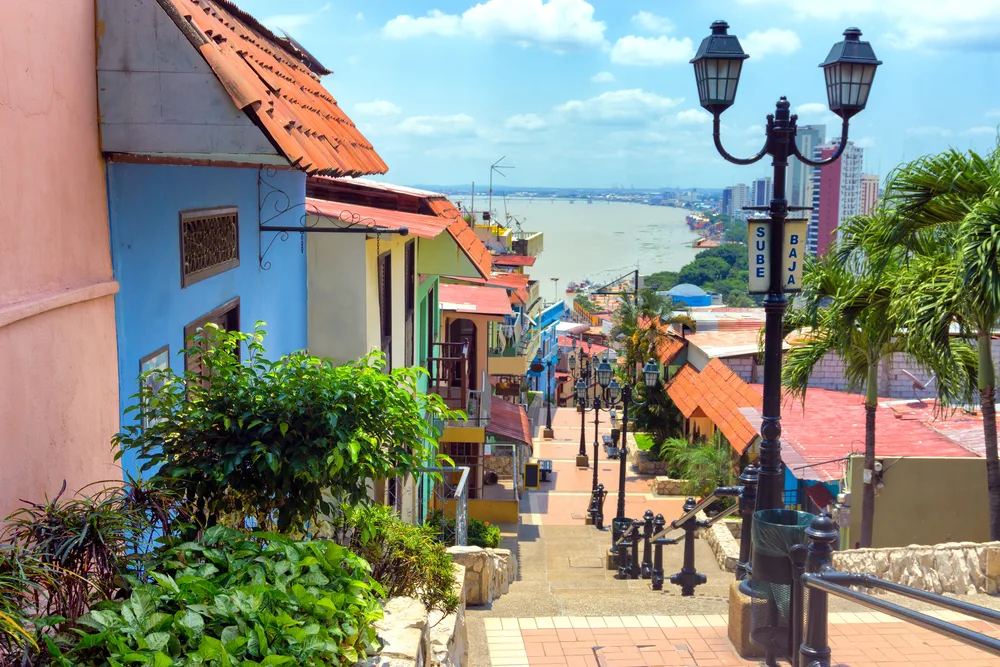
Jess Kraft/Shutterstock
Quito may be the capital, but the city of Guayaquil is Ecuador’s beating heart. This bustling port is also Ecuador’s largest city and boasts a great cultural scene that will intrigue visitors and locals alike.
Visitors to Guayaquil should check out the historical sites and get the lay of the land at Parque Histórico Guayaquil. Wander the streets to see the colorful houses, which are particularly concentrated around Las Peñas.
The biggest draw of Guayaquil is arguably the nightlife, some of the best in Ecuador.
The boardwalk along the Guayas River, Malecón 2000, has many bars, clubs, and ceviche places. Zona Rosa and Peñas have many clubs popular among local students that operate until the wee hours.
5. Mindo
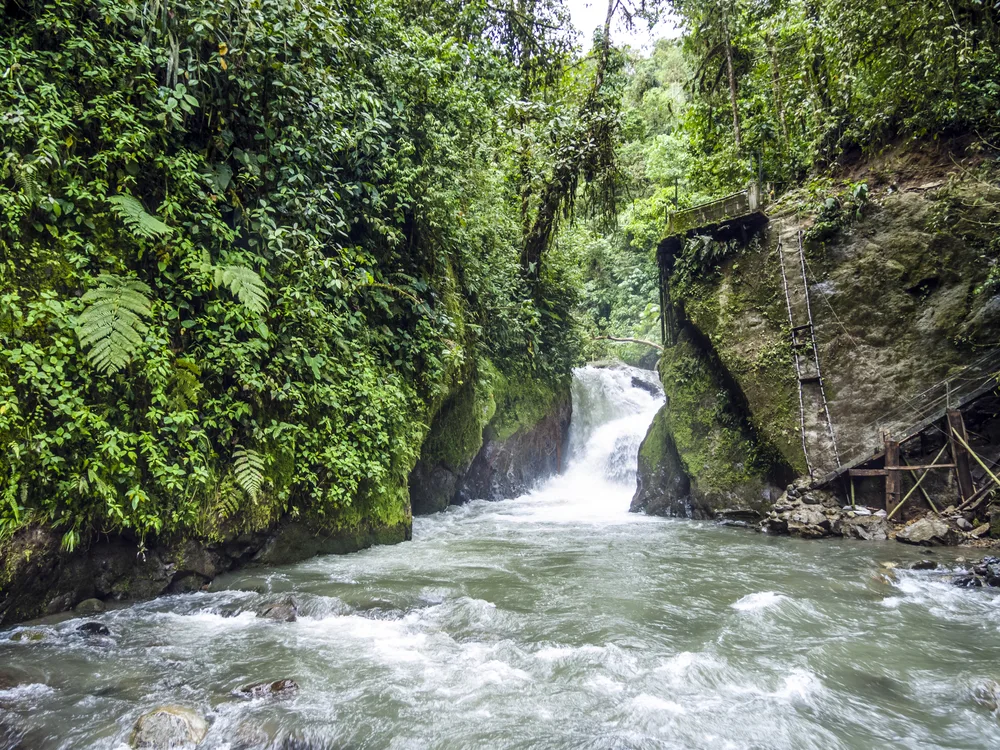
Travelview/Shutterstock
There is a reason why Mindo is one of the most popular stops on the informal backpacker circuit of Ecuador. This small town is located on the Andean slopes, where the Chocoan highlands meet the mountains, making it a great base to explore nature.
From Mindo, you can launch a number of outdoorsy adventures. The town itself is within the Mindo-Nambillo Ecological Reserve, making waterfalls, rapids, and hiking trails very close by.
Make sure to get into the cloud forest. True adrenaline junkies can try zip-lining and rafting, while hiking and walking are available for more sedate travelers.
6. Salinas
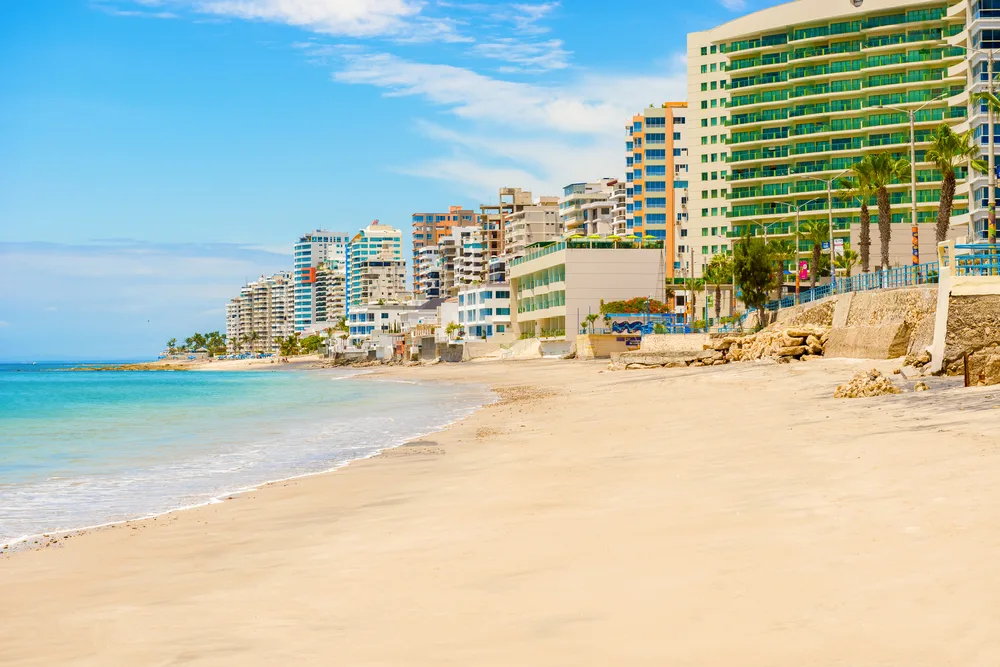
Salinas, Ecuador – April13, 2016: Modern condominium buildings facing the beach in Salinas, Ecuador/Marek Poplawski/Shutterstock
Most travelers think of the mountains or jungle when they think of Ecuador, but the country has a beautiful coastline along the Pacific Ocean with a loop of quaint beach towns. One of the most popular of those towns is Salinas.
Salinas is a pretty beach town that is both laid-back and vibrant. At night, the town lights up with a lively nightlife where you can rub elbows with dancing locals.
During the day, relax on the beach with a cocktail. Salinas is also a good base to explore neighboring beach towns such as relaxed Ayangue or Montañita, a backpacker’s paradise.
7. Quilotoa Loop

Ireneuke/Shutterstock
Experienced hikers heading to Ecuador will want to make a beeline for the Quilotoa Loop, a trail that runs through some of the most remote parts of the Andes.
The loop takes about three to four days to hike, especially since you will want to take your time and take in the sights. A major draw along the way is the inactive Quilotoa volcano, which has a pristine crater lake in the center.
Besides the natural wonders, you’ll get to take in the several indigenous villages along the way where people still hold onto their old ways of life. Try to time your hike to coincide with the local markets.
8. Baños de Agua Santa

Huge Brizard – YouGoPhoto/Shutterstock
If you want to explore the spectacular Amazon, follow most of the visiting backpackers and use Baños de Agua Santa as your base.
This town is colloquially known as “The Gateway to the Amazon” due to its proximity to the famous jungle and the fact that many tours depart from here. However, don’t skip out on exploring Baños in your hurry to get to the Amazon.
The town boasts many of its own charms, including natural hot springs fed by the nearby volcano, waterfalls including the Pailón del Diablo, and the pretty local market where you can try melcocha, a local candy.
9. Cuenca

Mark Pitt Images/Shutterstock
History lovers will adore Cuenca, another one of Ecuador’s UNESCO World Heritage towns. This southern Ecuadorian city boasts over 400 years of history, melding Spanish and local indigenous influences.
In Cuenca, check out the old town with examples of historic Spanish architecture such as the Old Cathedral of Cuenca, featuring Inca stones and Spanish architecture. This wouldn’t be Ecuador without some spectacular nature enough, so check out the Cajas National Park in the city’s backyard.
10. Otavalo

Christian Kohler/Shutterstock
Many of Ecuador’s people are indigenous and still maintain their traditions. Otavalo, a town in the north, is home to many members of the Otavalo indigenous group, making it a great place to learn about the culture of Ecuador’s original inhabitants.
The biggest attraction in Otavalo is easily the Otavalo market, where you can shop for traditional crafts such as alpaca wool clothing, art, and tagua nut jewelry. In June, the city hosts the Inti Raymi festival, a music festival dedicated to local indigenous music.
11. La Nariz del Diablo

ScottYellox/Shutterstock
La Nariz del Diablo translates to “the devil’s nose,” so you have an idea of what you’re getting into when you visit this rail network. The train that climbs up the mountain is not for the faint of heart, but it is worth it for the scenery.
Take the train that climbs up the many switchbacks to make it up the sheer face of the mountain and enjoy the spectacular views. At the base of the train ride, stop off in Riobamba, a city with a great, authentic market.
12. Ingapirca

Ammit Jack/Shutterstock
Before the Spanish came, the area that is now Ecuador was home to several indigenous groups with their own cultures and civilizations. Ingapirca is one of the best places to learn about this history. This site contains the best-preserved ruins in the country.
Located near Cuenca, Ingapirca contains a spectacular set of Inca ruins. The city is mostly rubble now as it was destroyed during the Spanish invasion, but you can still get a scale for the Inca masonry as you wander around the stone ruins, evading grazing llamas.
13. Chimborazo National Park
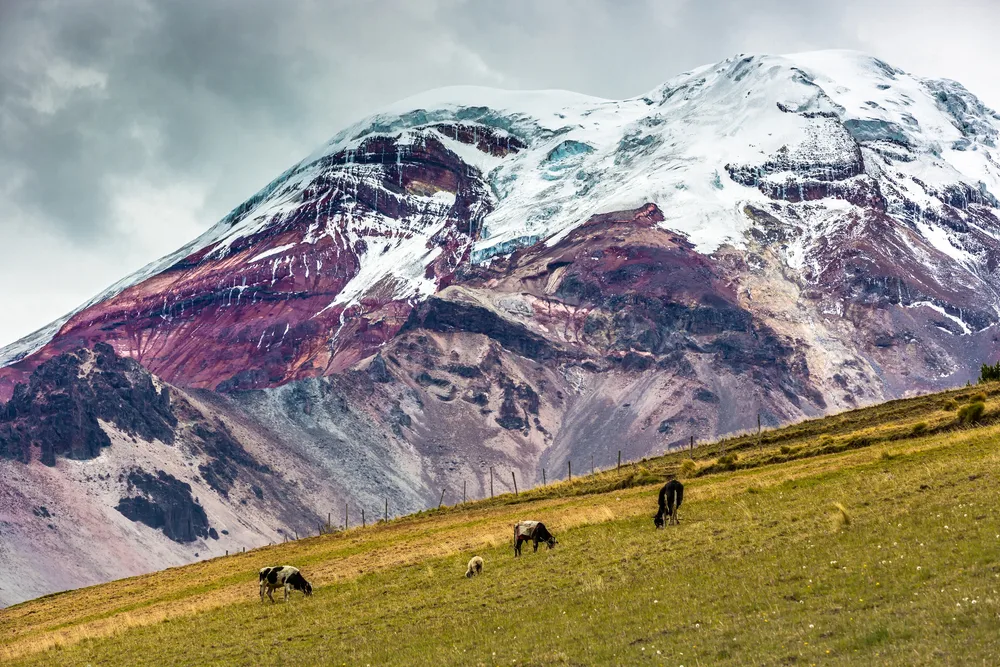
LMspencer/Shutterstock
Chimborazo National Park is another national park located along Ecuador’s Avenue of Volcanoes. It contains the highest mountain in Ecuador, Chimborazo, which is also the point on Earth that is closest to the sun.
A major draw of the park is hiking up Chimborazo itself, a challenging trek for even the most experienced hikers. The park also has many trails for hiking and biking, where you can check out the mountainous landscapes and get close to local wildlife such as vicuna.
14. Tena

Penta.tv/Shutterstock
Another city that offers a great base for visiting the Amazon is Tena. Tena is one of Ecuador’s centers of adventure tourism. You can leave on jungle tours that explore the Amazon, go whitewater rafting, or kayak down the Jatunyacu River.
Tena is also a great base for exploring the local cave systems near Archidona.
If you need a break from the adrenaline, learn more about the town’s history, which was the capital of cinnamon exploitation for the Spanish. Finally, don’t forget to take a relaxing stroll along the bridge above the Tena River.
15. The Equator
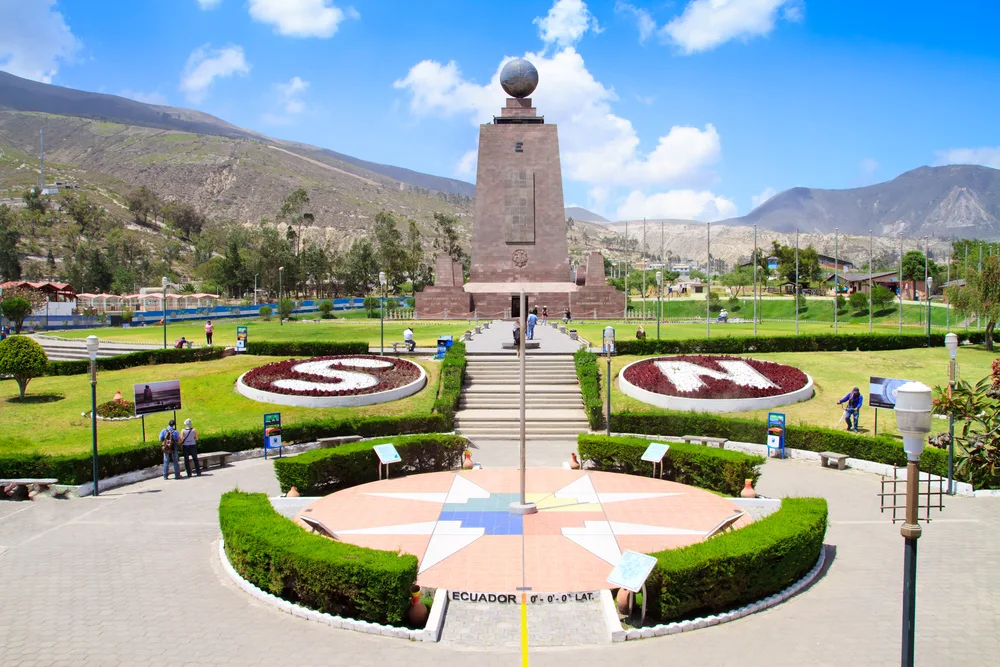
Fotos593/Shutterstock
The equator, the barrier between the Northern and Southern Hemisphere, gave Ecuador its name. It is a bit corny, but there are only a few other places in the world where you can stand with one foot in the Northern Hemisphere and one in the Southern!
Although Ecuador built a monument to the equator called Mitad del Mundo, the true equator lies a few hundred meters away.
Science buffs and lovers of strange phenomena can check out Museo Solar Inti Ñan, which shows you strange phenomena caused by the equator, such as toilet water swirling in different directions.
Things to Consider
Before you head to Ecuador, here are a few things to consider. First, Ecuador is mostly located in the Andes. Quito is the second-highest capital in the world. Most visitors are not used to these kinds of altitudes!
To avoid altitude sickness, spend a few days in Ecuador before trying to climb any mountains to let your body acclimate. The altitude makes every hike more strenuous than similar distances you might be used to back home, so keep that in mind. For some treks, it’s best to hire a local guide who can help you stay safe.
Finally, keep in mind that temperatures vary drastically depending on the region of the country you are exploring, the season, and the altitude. You’ll want to bring lots of layers!
Frequently Asked Questions

Alan Falcony/Shutterstock
Here are some other things fellow visitors to Ecuador wanted to know:
What is the best part of Ecuador?
There is no best part of Ecuador since the landscape is so diverse, so the best way to visit is to try and get a taste of each of the diverse regions. For the mountains, head to Cotopaxi National Park, don’t skip a trip into the Amazon Rainforest, and of course, visit the Galapagos Islands.
What is the best vacation destination in Ecuador?
The answer depends on what type of vacation you prefer, as history buffs, beach bums, and active adventurers will want very different things from their vacations. For a place truly like no other, the Galapagos Islands are your best bet.
What cities should I visit in Ecuador?
No trip to Ecuador is complete without a visit to the capital Quito. For lively nightlife, head to Guayaquil, and for a taste of culture and history, visit picturesque Cuenca.
What is the number one tourist attraction in Ecuador?
The Galapagos Islands are the most popular tourist destination in Ecuador, thanks to the unique wildlife, followed by Quito.
How many days in Ecuador is enough?
Most guides recommend spending two weeks or 15 days in Ecuador, as that gives you enough time to check out all of the diverse landscapes.
So, What Is the Best Place to Visit in Ecuador?
Ecuador is a nature lover’s paradise because it contains dramatic mountains, highlands, the Amazon jungle, and so much more.
Be sure to visit some of the many national parks, but first take some days to get used to the altitudes in a city such as Quito. So what are you waiting for — book your trip to Ecuador today!



